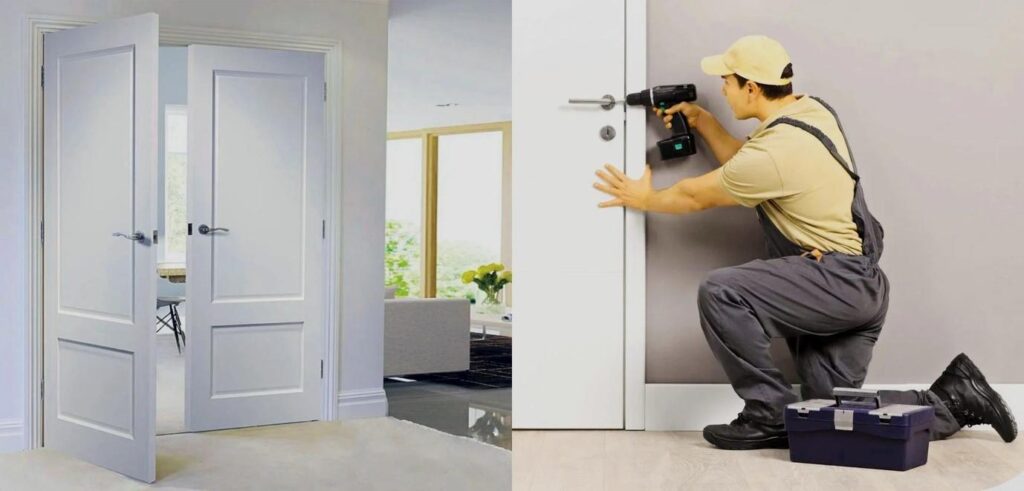Installing interior doors can seem like a daunting task for a beginner, but with the right approach and understanding of the basic steps, you can handle it yourself, notes Dennis Management company.
A high-quality door adds both security and aesthetic value to any property. Whether it’s for your home or office, choosing the right door can improve insulation, enhance privacy, and provide a welcoming entrance to visitors.
Why is Proper Installation of Interior Doors Important?
Interior doors play both a decorative and functional role. They provide:
- Sound insulation — helps reduce noise from other rooms.
- Thermal insulation — keeps the room warm, which is especially important during cold seasons.
- Comfort and privacy — separate spaces, creating a cozy atmosphere.
Proper installation of doors helps avoid issues with their use and increases comfort in the home.
IndigoDoors specializes in selling and installing interior doors, including those designed specifically interior doors for bathrooms, that are not only functional but also built to last for years to come.
How to Choose Interior Doors?
Before starting the installation, it’s crucial to choose the right door. Here are some tips:
- Material
Doors are made from various materials: wood, MDF, glass, and even plastic. Wood looks elegant and natural but requires care. MDF and plastic are easier to maintain and often less expensive, while glass adds a modern and visually light touch to your interior. - Size and Type of Door
Measure the opening before purchasing a door. Standard sizes do not always fit, and you may need to adjust the opening. Also, decide on the type of door: swinging, sliding, folding, or pivot — each has its own features. Modern homeowners love to check these cafe doors that blend vintage charm with practical design. They’re a popular choice for kitchens and home bars, adding style while keeping spaces connected. - Opening Type
If you have limited space, consider sliding or folding doors. Swinging doors require more space but are suitable for larger rooms.
Steps to Installing Interior Doors
Now let’s move on to the installation process. Here are the main steps:
1. Preparing the Doorway
This is an important step to start with.
- Assess the Condition of the Opening
Make sure the opening is level and free of cracks or chips. If the opening is too narrow or wide, it needs to be adjusted. - Clean the Opening
Remove any old paint, plaster, or other materials that may interfere with the installation. The opening should be clean and dry.
2. Installing the Door Frame
The frame is the foundation to which the door is attached. Correct installation is key to success.
- Assemble the Door Frame
Usually, it is assembled on the floor and then installed in the opening. Make sure all corners are square and the frame is level. - Fix the Frame in the Opening
Place the frame in the opening, using a level to ensure it is perfectly straight. Temporarily secure the frame with wedges or spacers.
3. Mounting the Door Leaf
Now it’s time to mount the door itself.
- Install the Hinges
Hinges are attached to both the door and the frame. Proper placement and attachment ensure smooth door operation. - Hang the Door Leaf
After installing the hinges, hang the door and check its opening and closing. If the door touches the floor or the frame, adjust the hinges.
4. Installing Moldings and Hardware
Once the door is installed, it’s time to add moldings and hardware.
- Secure the Moldings
Moldings cover the gaps between the door frame and the wall. They should match the color and style of the door. - Install the Hardware
Includes handles, locks, and latches. Make sure all elements work correctly and are convenient for you.
Tip: Pay attention to the quality of the hardware. Cheap hardware breaks quickly; it’s better to choose reputable manufacturers.
Common Mistakes When Installing Interior Doors and How to Avoid Them
- Not Properly Preparing the Opening
Before installation, the opening should be cleaned and leveled. Ignoring this step can cause issues with installation and door operation. - Improperly Securing the Door Frame
If the frame is not installed level, the door may become skewed, squeak, or get stuck. Use a level at every stage of the installation. - Using Low-Quality Hardware
Poor-quality hardware can wear out quickly, leading to replacing the entire door. It’s best to choose quality materials from the start. - Not Following Instructions
Door manufacturers often provide installation instructions that should be considered. They can help avoid many mistakes.
Useful Tips for Installing Interior Doors
- Use the Right Tools
A laser level and wood cutter will help you accurately measure and fit all parts. - Don’t Forget About Sealing
Seals improve sound insulation and protect against drafts. - Treat Wooden Parts
An antiseptic treatment will protect the wood from moisture and mold, extending its lifespan.
Installing interior doors is a task that you can do yourself if you carefully follow each step. Follow our recommendations to avoid mistakes and enjoy the results. “Proper installation is the key to the durability and reliability of your doors!“
Now you know the essential secrets to installing interior doors and are ready to handle this task without any problems!






